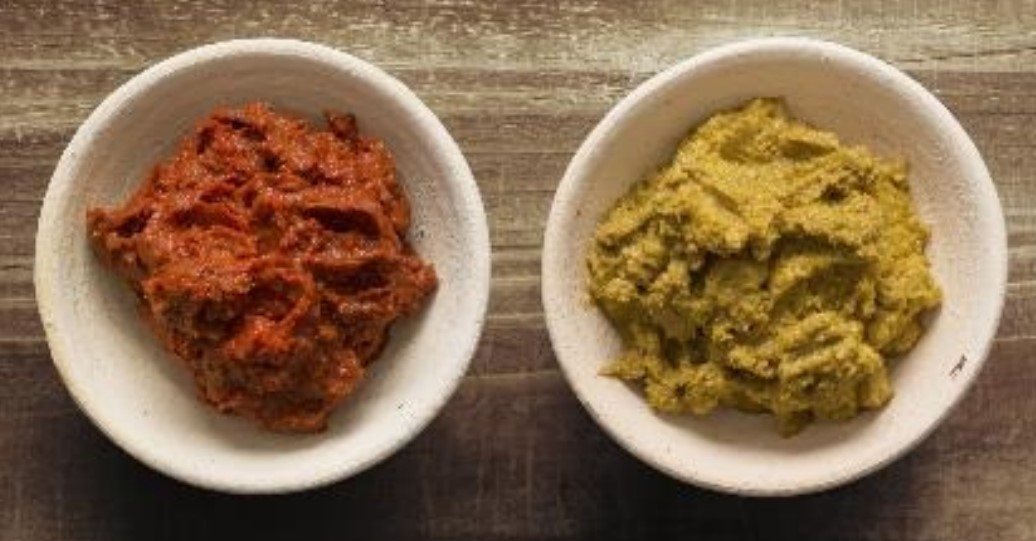This should not be prepared in advance, but there are several curry recipes that are using curry paste and I decided to take the curry paste recipe out and have it separately. So, when you see that the recipe is using curry paste, please go to this part of the book and prepare it from scratch or defrost of you have it frozen. Don’t use processed curry pastes or curry powder; make it every time from scratch. Keep the spices in original form (seeds, pods), ground them just before making the curry paste. You can dry heat in the skillet cloves, cardamom, cumin and coriander and then crush them coarsely with mortar and pestle.
ALLERGIES:
- SF (Shellfish-Free)
- GF (Gluten-Free)
- DF (Dairy-Free)
- EF (Egg-Free)
- V (Vegetarian)
- NF (Nut-Free)
INGREDIENTS:
- 2 onions, minced
- 2 cloves garlic, minced
- 2 teaspoons fresh ginger root, finely chopped
- 6 whole cloves
- 2 cardamom pods
- 2 (2-inch) pieces cinnamon sticks, crushed
- 1 tsp. ground cumin
- 1 tsp. ground coriander
- 1 tsp. salt
- 1 tsp. ground cayenne pepper
- 1 tsp. ground turmeric
INSTRUCTIONS:
- Heat oil in a frying pan over medium heat.
- Add minced onions to the pan and cook until transparent.
- Stir in minced garlic, chopped ginger, whole cloves, cardamom pods, crushed cinnamon sticks, ground cumin, ground coriander, salt, cayenne pepper, and ground turmeric.
- Cook for 1 minute over medium heat, stirring constantly.
- At this point, you can add other curry ingredients to complete your dish, or you can let the spice blend cool and freeze it for later use.
This curry spice blend forms the base of many flavorful curry dishes. By preparing and freezing it, you can have it readily available for future curry recipes. Simply thaw and use the spice blend whenever you’re ready to cook a delicious curry.
Curry paste is a flavorful and aromatic blend of spices, herbs, and other ingredients that is used as a base for making curry dishes. It is a key ingredient in various cuisines, including Thai, Indian, and Southeast Asian cooking.
Here’s some more information about curry paste:
- Flavor Profile: Curry paste is known for its rich, complex, and spicy flavor profile. The specific flavor can vary depending on the type of curry paste and the region it originates from. Common flavors found in curry paste include a combination of earthy, savory, sweet, and tangy notes.
- Ingredients: Curry paste typically contains a mixture of spices, herbs, aromatics, and sometimes chili peppers. Common ingredients found in curry paste include garlic, ginger, onions, lemongrass, galangal, coriander seeds, cumin seeds, turmeric, chili peppers, and various other herbs and spices.
- Varieties: There are numerous varieties of curry paste, each with its own unique flavor profile and ingredients. Some popular types of curry paste include red curry paste, green curry paste, yellow curry paste, Massaman curry paste, and Panang curry paste. Each variety may have different levels of spiciness and flavor intensity.
- Usage: Curry paste is typically used as a base ingredient to create curries, soups, stir-fries, marinades, and sauces. It adds depth, aroma, and a burst of flavor to dishes. Depending on the recipe, curry paste can be used alone or combined with other ingredients such as coconut milk, broth, or vegetables to create a complete curry dish.
- Homemade vs. Store-Bought: Curry paste can be purchased pre-made from stores, both in powdered and paste forms. However, making homemade curry paste allows for customization and control over the flavors and spice level. Homemade curry paste can be prepared using a mortar and pestle or a food processor to grind and blend the ingredients together.
It’s important to note that the spiciness of curry paste can vary, so it’s recommended to adjust the amount used in a recipe based on personal preference and tolerance for heat.
When using curry paste, follow the specific instructions of your chosen recipe to achieve the desired flavor and heat level. Store-bought curry pastes are usually stored in the refrigerator after opening, while homemade curry paste can be stored in an airtight container in the refrigerator for a few weeks or frozen for longer-term storage.
Experimenting with different types of curry paste can open up a world of delicious and diverse curry dishes in your cooking repertoire.


